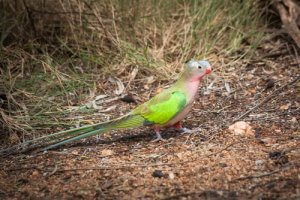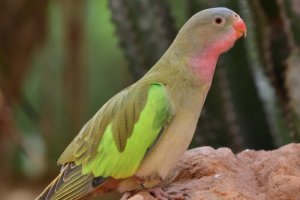Where Did the Princess Parrot Get Its Name?


Written and verified by biochemistry Luz Eduviges Thomas-Romero
The Princess parrot is a native Australian species with beautiful pale feathers. Their plumage is mainly green, with a pink throat, a bluish crown and throat, and bright green wings. It’s one of the friendliest and most affection parrots in the world.
The first recorded description of the Princess parrot
This task fell to the English naturalist and ornithologist, John Gould. In 1838, Gould and his wife set sail for Australia with the aim of studying the country’s birds and writing a new book on the subject.
The trip resulted in the publication of The Birds of Australia (1840-1848). The book was over 600 pages and 7 volumes long, containing details of 328 species which, at that time, were new to science. Over the years, the ornithologist named each new species, including the Princess parrot.
Today, the population of Alexandra’s parakeets seems to be in decline.
Who was Alexandra?
The eponymous Alexandra was Princess Alexandra of Denmark. At the age of 16, the British Royal family chose Alexandra to be the future wife of Albert Edward, Prince of Wales, and heir to Queen Victoria.
The royal couple married on March 10, 1863. Years later, in 1901, the Prince of Wales ascended to the throne as King Edward VII, and Alexandra became Queen consort of the United Kingdom and the British Dominion. She also held the title of the Empress consort of India.
Queen Alexandra greatly enjoyed socializing, and was a huge animal lover. She regularly attended dances, dinners, meetings, participated in charitable events, and visited hospitals and orphanages. She also raised money for many major public charities.
As a result, the British public adored and admired Queen Alexandra, so much so that they often tried to emulate her style and dress sense.

How common is it for birds to be named after famous people?
It’s actually quite common to name new species after famous historical figures. This is just one way to keep their memory alive. There are many examples among birds. For example, the bronze cuckoo and the Horsfield’s lark were named after the American naturalist Thomas Horsfield.
Two species were named in honor of the Australian artist and illustrator John Lewin: the Lewin’s rail and the Lewin’s honeyeater. Other examples include the Gouldian finch and the Gould’s petrel, which commemorate the ornithologist John Gould.
When it comes to royalty, there’s the Victoria’s riflebird, a bird of paradise named after Queen Victoria, and the Alexandra’s parakeet.
Species named after politicians
There are also several examples of politicians and heads of state that have had bird species named after them. So far, Barack Obama, Indira Gandhi, and Nelson Mandela have all received his honor.
But long before any of those, Philip Gidley King, Governor of New South Wales between 1800 and 1806, inspired the name of the Australian King Parrot.

Interesting facts about the Princess parrot
Princess parrots often attack in groups – a behavior that experts have never seen in any other species of parrot. The birds use this mobbing technique to deter predators. During the attack, they dive, squawk and even spray droppings at their target.
Another of their most notable characteristics is their penetrating call, which can be heard from miles away. When kept in captivity, their calls for attention can be almost deafening.
All cited sources were thoroughly reviewed by our team to ensure their quality, reliability, currency, and validity. The bibliography of this article was considered reliable and of academic or scientific accuracy.
- Smith, J. (2007). Gender, Royalty, and Sexuality in John Gould’s Birds of Australia. Victorian Literature and Culture, 35(2), 569-587.
- Collar, N. & Boesman, P. (2020). Princess Parrot (Polytelis alexandrae). In: del Hoyo, J., Elliott, A., Sargatal, J., Christie, D.A. & de Juana, E. (eds.). Handbook of the Birds of the World Alive. Lynx Edicions, Barcelona. (retrieved from https://www.hbw.com/node/54563 on 8 January 2020).
This text is provided for informational purposes only and does not replace consultation with a professional. If in doubt, consult your specialist.